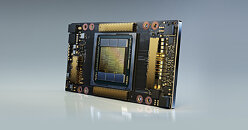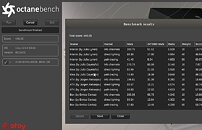Monday, July 27th 2020

NVIDIA Ampere A100 GPU Gets Benchmark and Takes the Crown of the Fastest GPU in the World
When NVIDIA introduced its Ampere A100 GPU, it was said to be the company's fastest creation yet. However, we didn't know how fast the GPU exactly is. With the whopping 6912 CUDA cores, the GPU can pack all that on a 7 nm die with 54 billion transistors. Paired with 40 GB of super-fast HBM2E memory with a bandwidth of 1555 GB/s, the GPU is set to be a good performer. And how fast it exactly is you might wonder? Well, thanks to the Jules Urbach, the CEO of OTOY, a software developer and maker of OctaneRender software, we have the first benchmark of the Ampere A100 GPU.
Scoring 446 points in OctaneBench, a benchmark for OctaneRender, the Ampere GPU takes the crown of the world's fastest GPU. The GeForce RTX 2080 Ti GPU scores 302 points, which makes the A100 GPU up to 47.7% faster than Turing. However, the fastest Turing card found in the benchmark database is the Quadro RTX 8000, which scored 328 points, showing that Turing is still holding well. The result of Ampere A100 was running with RTX turned off, which could yield additional performance if RTX was turned on and that part of the silicon started working.
Sources:
VideoCardz, Jules Urbach (Twitter)
Scoring 446 points in OctaneBench, a benchmark for OctaneRender, the Ampere GPU takes the crown of the world's fastest GPU. The GeForce RTX 2080 Ti GPU scores 302 points, which makes the A100 GPU up to 47.7% faster than Turing. However, the fastest Turing card found in the benchmark database is the Quadro RTX 8000, which scored 328 points, showing that Turing is still holding well. The result of Ampere A100 was running with RTX turned off, which could yield additional performance if RTX was turned on and that part of the silicon started working.


18 Comments on NVIDIA Ampere A100 GPU Gets Benchmark and Takes the Crown of the Fastest GPU in the World
So, solid rendering performance of this compute card. Cool. :)
Let me know when he wakes up and compares it to compute cards only.
Also, extremely curious once perhaps yields are more mature (I feel uncertain in how long that might take, considering the gigantic size of the each die), how a fully enabled (potentially higher clocked) die of an A100 would perform. This only seems like good news though for any corporation interesting in it, considering how fully integrated its compute capabilities are into that single die/chip.